Gold Silver Reports – Rolls-Royce Makes Gold Out of Base Metals — If you’re a customer of Rolls-Royce Plc, there’s a fair bet you got a call toward the end of last year, politely asking you to pay your bill.
The British maker of aircraft engines is under pressure to show investors that it can generate more cash, even as it’s losing money on the new models it’s shipping to customers. Making its task more difficult is the fact that its Trent engines already in service are suffering technical problems and need expensive repairs.
A 550 million-pound ($763 million) improvement in working capital management — shorthand for getting customers to pay up — was a big reason why free cash flow more than doubled to 273 million pounds last year. Investors aren’t bothered where the money comes from, so long as it shows up. The shares soared as much as 15 percent on Wednesday.
Working capital wasn’t the only lever pulled by CEO Warren East to flatter the 2017 result. Instead of expensing research and development costs via the profit and loss statement, Rolls-Royce capitalized more than 340 million pounds of R&D on the balance sheet — three times more than in 2016.
So R&D expenses fell 18 percent year-on-year, even though Rolls-Royce actually spent more. In fairness, its development programs are now more advanced and therefore qualify in Europe as an investment, not a cost. But if Rolls-Royce had booked the same R&D expenses as last year, the improvement in pretax profit would have been much less impressive.
There are other reasons why shareholders shouldn’t get carried away. Despite much better free cash flow, net debt doubled at the end of 2017 to 520 million pounds because of dividend payments and fines paid to settle British and U.S. bribery probes. 1
In addition, under the new IFRS 15 revenue-recognition rules that Rolls-Royce is adopting from this year, its core civil aerospace division made a 330 million-pound loss last year, rather than the reported 520 million-pound profit. It’s expected to remain unprofitable in 2018 on that basis. The company will also have to take a 5.2 billion-pound hit to net assets because of the accounting change, leaving precious little shareholder equity.
That’s a worry because Rolls-Royce will probably incur another 340 million cash outflow in 2018 related to those troubles on its Trent 900 and 1000 engines. While those costs are included in Rolls-Royce’s cash flow guidance for 2018 (estimated at about 450 million pounds), it’s a reminder of the risks in large aircraft engine programs. Better capitalized rivals such as United Technologies Corp’s Pratt & Whitney unit are wrestling too with problems on new engines.
Read More: MCX Zinc Trading Zone key level Between 208—214
Arguably, Rolls-Royce shareholders aren’t being properly rewarded for these risks. Under IFRS 15, Rolls-Royce achieved just 43 million pounds of underlying net profit in 2017, which would mean the shares trade on 400 times last year’s earnings. 2 Investors are happy to ignore that oddity so long as the company delivers a promised one billion pounds of yearly free cash flow by 2020. East’s recovery program remains on track, but he’ll need plenty more wizardry to get there. – Goldman Neal Bhai Reports

